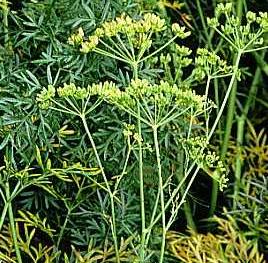
ASAFETIDA, DEVIL’S DUNG (Ferula assa-foetida L.) ++
Labeled Ferula foetida in AHP, KAP, and PH2.
Activities (Asafetida) — Alexeritic (f; DAA); Allergenic (f; CRC); Analgesic (f; CRC); Antiaggregant
(1; CAN; CRC; DAA; PNC); Antiseptic (f; PHR; PH2); Antispasmodic (f; CAN; CRC);
Antitumor (1; APA; PH2); Aperient (f; CRC); Aphrodisiac (f; APA); Carminative (1; APA; CAN;
CRC; RIN); CNS-Stimulant (1; WOI); Deobstruent (f; DAA); Deodorant (f; DAA); Digestive (f;
APA; DAA); Diuretic (f; CRC); Emmenagogue (f; APA; CRC); Enterostimulant (1; WOI); Expectorant
(1; APA; CAN; CRC; RIN); Fungicide (f; APA); Hypotensive (1; CAN; CRC; PNC); Laxative
(f; CRC; DAA); Mutagenic (1; PH2); Nervine (f; CRC); Respirastimulant (1; WOI); Sedative (f;
PHR; PH2); Stimulant (f; CRC; DAA); Stomachic (f; CRC; DAA); Uterotonic (f; AHP); Vermifuge
(f; CRC; DAA).
Indications (Asafetida) — Amenorrhea (f; CRC); Asthma (1; APA; CRC; WOI); Bronchosis
(1; APA; CAN; WOI); Callus (f; JLH); Cancer (1; APA; PH2); Cancer, abdomen (1; APA);
Cancer, gum (f; JLH); Cancer, liver (f; JLH); Cholera (f; CRC; SKJ; WOI); Colic (f; APA;
CAN; CRC); Cold (f; TAD); Colitis (f; APA; PHR; PH2); Constipation (f; PH2); Convulsion
(f; CRC); Corn (f; JLH); Cough (f; PNC); Cramp (f; CAN; CRC; SKJ); Croup (f; CRC);
Diarrhea (f; PH2); Dyspepsia (1; APA; CAN; PH2); Enterosis (f; APA; CRC; PH2); Epilepsy
(f; APA; CRC; PH2; WOI); Felon (f; JLH); Flatulence (1; APA; PNC; WOI); Fracture (f;
CRC); Frigidity (f; APA); Fungus (f; APA); Gas (1; APA; CAN; CRC; HHB; RIN); Gastrosis
(f; PHR; PH2); Gingivosis (f; JLH); Hemiplegia (f; CRC); Hepatosis (f; JLH; PH2); High
Blood Pressure (1; CAN; CRC; PNC; DAA); Hyperlipidemia (f; CAN); Hypoacidity (f; PH2);
Hypoglycemia (f; APA); Hysteria (f; APA; CAN; WOI); IBS (2; CAN); Impotence (f; APA);
Indigestion (1; APA; CAN); Induration (f; JLH); Infection (f; APA; PHR; PH2); Insanity (f;
CRC); Insomnia (f; PHR; PH2); Laryngismus (f; CAN); Mucososis (1; APA; CAN); Mycosis
(f; APA); Nervousness (f; PHR; PH2); Neurasthenia (f; CRC; DAA); Neurosis (1; APA);
Osteosis (f; CRC); Pain (f; CRC); Parasite (f; PH2); Pertussis (f; CAN; CRC; PH2; WOI);
Pneumonia (f; SKJ); Polyp (f; CRC); Rheumatism (f; CRC); Rinderpest (f; CRC); Sarcoma
(f; CRC); Splenosis (f; CRC; PH2); Stomachache (1; APA; CRC); Thrombosis (1; CAN; PNC);
Tumor (1; APA; PH2); Wart (f; JLH); Water Retention (f; CRC); Whitlow (f; JLH); Worm (f;
CRC; DAA).
Dosages (Asafetida) — 0.3–1 g asafetida resin 3 ×/day (APA; CAN; HHB; PNC); 2–4 ml asafetida
tincture (CAN, PNC); 20 drops tincture (PH2).
Contraindications, Interactions, and Side Effects (Asafetida) — Class 2b, 2d. Contraindicated
for infant colic. Emmenagogue, uterotonic (AHP).“Hazards and/or side effects not known for
proper therapeutic dosages” (PH2). Bitter acrid taste and disagreeable garlic-like odor, due mostly
to its volatile oil. Odor imparted through excretions and eructations. Medicinal use may result
in swollen lips, gastric burning, belching, flatulence, diarrhea, burning during urination, headache,
dizziness, and convulsion (AEH; PHR; PH2). The gum of related species is an irritant to the
skin and stomach, and causes dermatosis (CAN). Sulfur compounds in the oil may protect against
fat-induced hyperlipidemia. Two double-blind studies report asafetida useful for irritable bowel
syndrome (just below 5% significance level in one, near 1% in the other) (CAN). Because it is
reputed to affect the menstrual cycle and to be an abortifacient, its use in pregnancy and lactation
is to be avoided. It oxidizes fetal hemoglobin but not adult hemoglobin. Coumarins may interfere
with coagulation therapy and may cause chromosomal damage (CAN). 50–100 mg resin reported
to cause convulsions in nervous people (AHP). Do not give to children; may cause methemoglobinemia
(APA).



0 comments:
Post a Comment